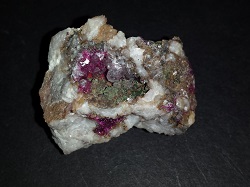A- |
B- |
C- |
D- |
E- |
F- |
G- |
H- |
I- |
J- |
K- |
L- |
M- |
N- |
O- |
P- |
Q- |
R- |
S- |
T- |
U- |
V- |
W- |
X- |
Y- |
Z |
Roselite is in a solid solution series with the mineral wendwilsonite, (Hydrated Calcium Magnesium Cobalt Arsenate). A solid solution series is a situation in which two or more elements are able to occupy the same position in the structures of two or more minerals. In this case, the two elements are cobalt and magnesium and they can replace each other in the roselite/wendwilsonite structure. If the particular crystal is rich in cobalt, then the mineral is roselite; if the crystal is rich in magnesium, then the mineral is wendwilsonite.
Roselite is dimorphous with the much rarer, but sometimes associated mineral beta-roselite. Beta-roselite is triclinic instead of monoclinic in symmetry like roselite. The symmetry difference is due to a different structure, yet the two minerals have the same formula. This is why they are called dimorphous (di means two; morph means shape). Roselite lends its name to a small group of rather obscure minerals called the Roselite Group. The Roselite Group is a group of monoclinic, hydrated calcium arsenates with a general formula of Ca2X(AsO4)2 - 2H2O The X in the formula can be either cobalt, manganese, magnesium and/or zinc.
These are the members of the Roselite Group:
Brandtite (Hydrated Calcium Manganese Magnesium Cobalt Arsenate)
Roselite (Hydrated Calcium Cobalt Magnesium Arsenate)
Wendwilsonite (Hydrated Calcium Magnesium Cobalt Arsenate)
Zincroselite (Hydrated Calcium Zinc Arsenate)
PHYSICAL CHARACTERISTICS:
Color is rose-red to dark pink (lighter shades with decreasing cobalt content).
Luster is vitreous.
Transparency: Crystals are transparent to translucent.
Crystal System is monoclinic; 2/m.
Crystal Habits include small prismatic to tabular, often complex, crystals and spherical aggregates and massive crusts. Twinning is the norm and just adds to the complexity of the crystals.
Cleavage is perfect in one direction.
Fracture is uneven.
Hardness is 3.5
Specific Gravity is approximately 3.5 - 3.7 (above average for translucent minerals).
Streak is light red.
Associated Minerals are erythrite, beta-roselite and limonite. Notable Occurrences include Rappold Mine, Schneeberg, Saxony and Shapbach, Germany and Bou Azzer, Morocco.
Best Field Indicators are color, crystal habit, streak, cleavage, density and associations with cobalt ores.








